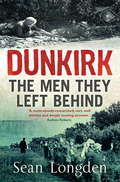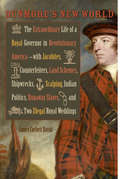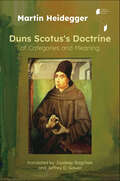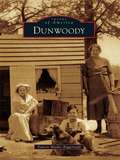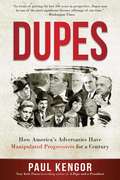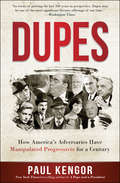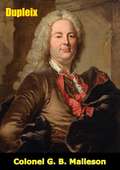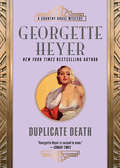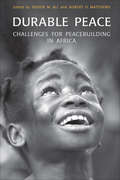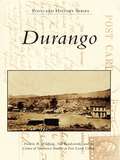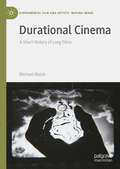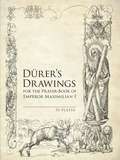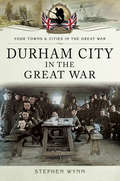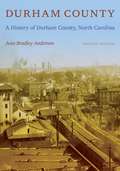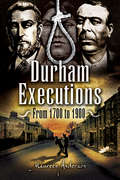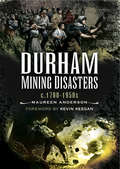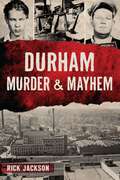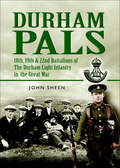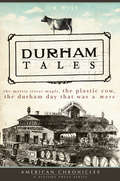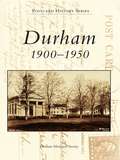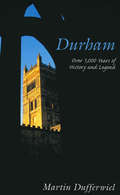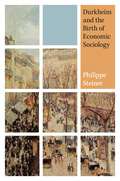- Table View
- List View
Dunkirk: The Men They Left Behind
by Sean LongdenTHE TRUE STORY OF THE 41,000 BRITISH SOLDIERS WHO WERE LEFT BEHIND AFTER THE EVACUATION OF DUNKIRK, MAY 1940'Meticulously researched, very well written and deeply moving' Andrew Roberts'Few readers will be unmoved by Sean Longden's account' Dominic SandbrookAt 2am on the morning of the 3rd of June 1940, General Harold Alexander searched along the quayside, holding onto his megaphone and called "Is anyone there? Is anyone there?" before turning his boat back towards England. Tradition tells us that the dramatic events of the evacuation of Dunkirk, in which 300,000 BEF servicemen escaped the Nazis, was a victory gained from the jaws of defeat. For the first time, rather than telling the tale of the 300,000 who escaped, Sean Longden reveals the story of the 40,000 men sacrificed in the rearguard battles.On the beaches and sand dunes, besides the roads and amidst the ruins lay the corpses of hundreds who had not reached the boats. Elsewhere, hospitals full of the sick and wounded who had been left behind to receive treatment from the enemy's doctors. And further afield - still fighting hard alongside their French allies - was the entire 51st Highland Division, whose war had not finished as the last boats slipped away. Also scattered across the countryside were hundreds of lost and lonely soldiers. These 'evaders' had also missed the boats and were now desperately trying to make their own way home, either by walking across France or rowing across the channel. The majority, however, were now prisoners of war who were forced to walk on the death marches all the way to the camps in Germany and Poland, where they were forgotten until 1945.'Sean Longden is a rising name in military history, and is able to uncover the missing stories of the Second World War' Guardian
Dunmore's New World: The Extraordinary Life of a Royal Governor in Revolutionary America--with Jacobites, Counterfeiters, Land Schemes, Shipwrecks, Scalping, Indian Politics, Runaway Slaves, and Two Illegal Royal Weddings (Early American Histories)
by James Corbett DavidDunmore's New World tells the stranger-than-fiction story of Lord Dunmore, the last royal governor of Virginia, whose long-neglected life boasts a measure of scandal and intrigue rare in the annals of the colonial world. Dunmore not only issued the first formal proclamation of emancipation in American history; he also undertook an unauthorized Indian war in the Ohio Valley, now known as Dunmore's War, that was instrumental in opening the Kentucky country to white settlement. In this entertaining biography, James Corbett David brings together a rich cast of characters as he follows Dunmore on his perilous path through the Atlantic world from 1745 to 1809.Dunmore was a Scots aristocrat who, even with a family history of treason, managed to obtain a commission in the British army, a seat in the House of Lords, and three executive appointments in the American colonies. He was an unusual figure, deeply invested in the imperial system but quick to break with convention. Despite his 1775 proclamation promising freedom to slaves of Virginia rebels, Dunmore was himself a slaveholder at a time when the African slave trade was facing tremendous popular opposition in Great Britain. He also supported his daughter throughout the scandal that followed her secret, illegal marriage to the youngest son of George III--a relationship that produced two illegitimate children, both first cousins of Queen Victoria. Within this single narrative, Dunmore interacts with Jacobites, slaves, land speculators, frontiersmen, Scots merchants, poor white fishermen, the French, the Spanish, Shawnees, Creeks, patriots, loyalists, princes, kings, and a host of others. This history captures the vibrant diversity of the political universe that Dunmore inhabited alongside the likes of George Washington and Thomas Jefferson. A transgressive imperialist, Dunmore had an astounding career that charts the boundaries of what was possible in the Atlantic world in the Age of Revolution.
Duns Scotus's Doctrine of Categories and Meaning (Studies in Continental Thought)
by Martin HeideggerDuns Scotus's Doctrine of Categories and Meaning is a key text for the origins of Martin Heidegger's concept of "facticity." Originally submitted as a postdoctoral thesis in 1915, it focuses on the 13th-century philosopher-theologian John Duns Scotus. Heidegger first analyzes Scotus's doctrine of categories, then offers a meticulous explanation of the Grammatica Speculativa, a work of medieval grammar now known to be authored by the Modist grammarian Thomas of Erfurt. Taken together, these investigations represent an early foray into Heidegger's lifelong philosophical concerns, "the question of being in the guise of the problem of categories and the question of language in the guise of the doctrine of meaning."This new and unique translation of one of Heidegger's earliest works offers an important look at his early thinking before the question of being became his central concern and will appeal to readers exploring Heidegger's philosophical development, medieval philosophy, phenomenological interpretations of the history of philosophy, and the philosophy of language.
Dunwoody (Images of America)
by Valerie M. BiggerstaffThe name Dunwoody developed from a spelling error. Soon after the Civil War ended, Maj. Charles Dunwody left nearby Roswell to settle in a new community and decided to start a post office. The post office added one "o" to his name, and from that moment, the area was known as Dunwoody. Beginning as a humble farming community, Dunwoody grew into a popular suburb of Atlanta. Careful growth control, under the supervision of the Dunwoody Homeowners Association, kept Dunwoody from becoming too developed. The Dunwoody Preservation Trust works to identify and save Dunwoody's historical landmarks. The Dunwoody Farmhouse, located at the central crossroads of the community, is one of the trust's success stories and is enjoyed by many.
Dupes: How America's Adversaries Have Manipulated Progressives for a Century
by Paul KengorIn this startling, intensively researched book, bestselling historian Paul Kengor shines light on a deeply troubling aspect of American history: the prominent role of the "dupe." From the Bolshevik Revolution through the Cold War and right up to the present, many progressives have unwittingly aided some of America's most dangerous opponents. Based on never-before-published FBI files, Soviet archives, and other primary sources, Dupes exposes the legions of liberals who have furthered the objectives of America's adversaries. Kengor shows not only how such dupes contributed to history's most destructive ideology—Communism, which claimed at least 100 million lives—but also why they are so relevant to today's politics.
Dupes: How America’s Adversaries Have Manipulated Progressives for a Century
by Paul Kengor"Nothing short of horrifying . . . In terms of putting the last 100 years in perspective, Dupes may be one of the most significant literary offerings of our time." --Washington TimesIn this startling, intensively researched book, bestselling historian Paul Kengor shines light on a deeply troubling aspect of American history: the prominent role of the "dupe." From the Bolshevik Revolution through the Cold War and right up to the present, many progressives have unwittingly aided some of America's most dangerous opponents.Based on never-before-published FBI files, Soviet archives, and other primary sources, Dupes reveals:*Shocking reports on how Senator Ted Kennedy secretly approached the Soviet leadership to undermine not one but two American presidents*Stunning new evidence that Frank Marshall Davis--mentor to a young Barack Obama--had extensive Communist ties and demonized Democrats*Jimmy Carter's woeful record dealing with America's two chief foes of the past century, Communism and Islamism*Today's dupes, including the congressmen whose overseas anti-American propaganda trip was allegedly financed by foreign intelligence*How Franklin Roosevelt was duped by "Uncle Joe" Stalin--and by a top adviser who may have been a Soviet agent--despite clear warnings from fellow Democrats*How John Kerry's accusations that American soldiers committed war crimes in Vietnam may have been the product of Soviet disinformation*The many Hollywood stars who were duped, including Humphrey Bogart, Lauren Bacall, Katharine Hepburn, Gene Kelly--and even Ronald Reagan
Dupleix
by Colonel G. B. MallesonA biographical sketch of Joseph-François, Marquis Dupleix (1 January 1697 - 10 November 1763), Governor-General of French India, written by noted historian G. B. Malleson. He highlights the 'system of Dupleix' and his qualities, describing him as a great organizer, a man of comprehensive and accurate views and a man of resolute will.
Duplicate Death (Country House Mysteries #11)
by Georgette HeyerAn elegant card party turns deadly...Inspector Hemingway has his work cut out for him when a seemingly civilized game of Duplicate Bridge leads to a double murder. The crimes seem identical, but were they carried out by the same hand? Things become even more complicated when the fiancée of the inspector's young friend Timothy Kane becomes Hemingway's prime suspect. Kane is determined to prove the lady's innocence—but when he begins digging into her past, he finds it's more than a little bit shady...Praise for Georgette Heyer:"Ranks alongside such incomparable whodunit authors as Christie, Marsh, Tey, and Allingham." —San Francisco Chronicle"The wittiest of detective story writers." —Daily Mail"Pungent dialogue and A1 characterization." —Time magazine"Ms. Heyer is one of the most entertaining writers I have ever read." —Reading Extravaganza"Miss Heyer has the delightful talent of blending humor with mystery." —Boston Evening Transcript
Duquesa Por Engano: Os Haverstocks, Livro 2
by Cheryl BolenOutra das clássicas estórias de casamento por conveniência escrita por Cheryl Bolen Uma inocente visita ao Duque de Aldridge para pedir uma doação para suas viúvas de guerra, coloca Lady Elizabeth Upton no meio de um enorme escândalo... O Duque de Aldridge pede a mão de Lady Elizabeth Upton, irmã de seu melhor amigo, depois que uma confusão a envia para seu quarto de dormir – bem quando ele está saindo de seu banho. Ela certamente não quer forçar o duque a esse casamento, mas como ela pode suportar a vergonha que seu comportamento escandaloso lançou sobre seu querido irmão, o Marquês de Haverstock? Uma vez que ela concorda em se casar com seu ídolo e galã de infância, Elizabeth percebe que ela não quer nada além de conquistar o amor de seu marido. Mas capturar seu coração não é uma tarefa fácil quando antigos amores ameaçam destruir os frágeis laços de seu casamento.
Duquesa por Error: La Casa de Haverstock
by Cheryl BolenOtra de las historias clásicas de matrimonio por conveniencia de Cheryl Bolen. Una visita inocente al duque de Aldridge para solicitar una donación para sus viudas de guerra pone a Lady Elizabeth Upton en medio de un escándalo más impactante. . . El duque de Aldridge se ofrece por la hermana de su mejor amigo, Lady Elizabeth Upton, después de que una confusión la envía a su dormitorio, justo cuando él sale de su baño. Ciertamente no quiere forzar la mano del duque, pero ¿cómo puede soportar la vergüenza que su comportamiento escandaloso ha arrojado sobre su querido hermano, el marqués de Haverstock? Una vez que acepta casarse con el rompecorazones de la infancia, Elizabeth se da cuenta de que no quiere nada más que ganarse el amor de su marido. Pero capturar su corazón no es una tarea fácil cuando los amores anteriores amenazan con destruir los frágiles lazos de su matrimonio.
Durable Peace: Challenges for Peacebuilding in Africa
by Robert Matthews Taisier AliThe African continent has been racked with war in the years since decolonization. In the aftermath of violent conflict, peace is often fragile. With Durable Peace, Taisier M. Ali and Robert O. Matthews have brought together leading scholars to discuss the experiences of ten African countries - Angola, Ethiopia, Liberia, Mozambique, Rwanda, Somalia, South Africa, Sudan, Uganda, and Zimbabwe - in recovering from violent civil war.In this series of remarkable and thought-provoking essays, the contributors shed light on the process of peacebuilding. Collectively, they demonstrate that if efforts to restore peace in war-torn societies are to be successful, such efforts must be wide in scope, involving security and political issues, as well as economic development and socio-psychological reconciliation. Additionally, they must be extended over long periods of time and, above all else, anchored in the local community.Peacebuilding is a difficult process, subject to frequent setbacks, and sometimes outright failure. Durable Peace concludes that any peacebuilding effort must include at least four building blocks: a secure environment, new political institutions that are broadly representative, a healthy economy, and a mechanism for dealing with injustices of the past and future. How these blocks are put together will vary, but if they are arranged to fit the specific local circumstances, the outcome will likely be self-sustaining peace.
Durango
by Center of Southwest Studies at Fort Lewis College Nik Kendzioski Frederic B. WildfangThis collection presents a postcard tour of Durango and its environs and provides keen insight into the history and colorful character of this area, which has been a vibrant center of Southwestern Colorado for more than a century. A brief history of postcards as a convenient medium for sharing messages--and as a revolutionary departure from Victorian-era long letters--is included here as well. The Center of Southwest Studies at Fort Lewis College is pleased to present these evocative images gathered by the indefatigable Nina Heald Webber.
Durational Cinema: A Short History of Long Films (Experimental Film and Artists’ Moving Image)
by Michael WalshThis book argues for a durational cinema that is distinct from slow cinema, and outlines the history of its three main waves: the New York avant-garde of the 1960s, the European art cinema in the years after 1968, and the international cinema of gallery spaces as well as film festivals since the 1990s. Figures studied include Andy Warhol, Ken Jacobs, Chantal Akerman, Marguerite Duras, Claude Lanzmann, James Benning, Kevin Jerome Everson, Lav Diaz, and Wang Bing.Durational cinema is predominantly minimal, but has from the beginning also included a more encompassing or encyclopedic kind of filmmaking. Durational cinema is characteristically representational, and converges on certain topics (the Holocaust, deindustrialization, the experience of the working class and other marginalized people), but has no one meaning, signifying differently at different moments and in different hands. Warhol’s durational cinema of subtraction is quite different from Jacobs’s durational cinema of social disgust, while Lav Diaz’ durational sublime is quite different from Kevin Jerome Everson’s unblinking studies of African-American working people.
Durer's Drawings for the Prayer-Book of Emperor Maximilian I: 53 Plates
by Albrecht DurerHoly Roman Emperor and King of the Germans Maximilian I was Albrecht Dürer's main patron from 1512 onward. These 45 pages of marginal drawings for the ruler's prayer book, unknown till their 1808 facsimile publication, reveal the artist's lighthearted and witty side. Includes 8 additional drawings by other artists and a new Introduction.
Duress: Imperial Durabilities in Our Times
by Ann Laura StolerHow do colonial histories matter to the urgencies and conditions of our current world? How have those histories so often been rendered as leftovers, as "legacies" of a dead past rather than as active and violating forces in the world today? With precision and clarity, Ann Laura Stoler argues that recognizing "colonial presence" may have as much to do with how the connections between colonial histories and the present are expected to look as it does with how they are expected to be. In Duress, Stoler considers what methodological renovations might serve to write histories that yield neither to smooth continuities nor to abrupt epochal breaks. Capturing the uneven, recursive qualities of the visions and practices that imperial formations have animated, Stoler works through a set of conceptual and concrete reconsiderations that locate the political effects and practices that imperial projects produce: occluded histories, gradated sovereignties, affective security regimes, "new" racisms, bodily exposures, active debris, and carceral archipelagos of colony and camp that carve out the distribution of inequities and deep fault lines of duress today.
Durham City in the Great War (Your Towns & Cities in the Great War)
by Stephen WynnDurham was, and still is, one of the country's oldest and best-loved cites. The very name was synonymous with dedication, dependability and determination. Men from the city answered the call to arms with an eerie normality, no matter what their age or social class. Many had been miners before the war and had spent their working life down a pit, but just as many had been teachers. Others were students at the Durham School, one of the most prestigious in the land, going on to further greatness at Durham University. When the announcement of war was made, they all enlisted to do their duty for King and country. They asked nothing in return, despite knowing the inherent dangers of what they were about to do. They carried on regardless, selfless in their readiness to give to a greater cause.There was a similar determination amongst the city's people. For some that meant working for the local Voluntary Aid Detachment or the Durham Volunteer Training Corps, whilst still going about their day job. They knew that no matter how hard things were for them, it was much more trying for their sons, brothers, husbands, uncles and other loved ones who were fighting on the Western Front.Hundreds went off to fight in the war: men who had been born in the city, who lived and were educated in the city, and men who had worked in the city. Some 360 of them never made it home. They are gone, but never forgotten.
Durham County: A History of Durham County, North Carolina
by Jean Bradley AndersonIn this revised and expanded second edition of Durham County, Jean Bradley Anderson extends her sweeping history of Durham from the seventeenth century to the end of the twentieth. Moving beyond traditional local histories, which tend to focus on powerful families, Anderson integrates the stories of well-known figures with those of ordinary men and women, blacks and whites, to create a complex and fascinating portrait of Durham's economic, political, social, and labor history. Drawing on extensive primary research, she examines the origins of the town of Durham and recounts the growth of communities around mills, stores, taverns, and churches in the century before the rise of tobacco manufacturing. A historical narrative encompassing the coming of the railroad; the connection between the Civil War and the rise of the tobacco industry; the Confederate surrender at Bennett Place; the relocation of Trinity College to Durham and, later, its renaming as Duke University; and the growth of health-service and high-technology industries in the decades after the development of Research Triangle Park, this second edition of Durham County is a remarkably comprehensive work.
Durham Executions: From 1700 to 1900
by Maureen AndersonWidespread poverty continued to exist in Durham at the start of the twentieth century. Improvement in working and housing conditions was a slow. Wages in dominant industries associated with iron and coal were higher than those who still worked on the land, in service and elsewhere but, for most families, it was a hard existence. The social and economic context of capital crimes are apparent in many of the cases featured in this volume. Alcohol-fuelled jealousy or the need for money was often the prelude to a meeting with the executioner. The voices against capital punishment became louder as the century progressed—but too late for the 55 men hanged at Durham, the last in 1958. Executions took place in private and, though witnessed, were not the great public spectacles of the past—but they provided good copy the newspapers of the day and the hangmen maintained a celebrity status.
Durham Mining Disasters, c. 1700–1950s: C1700-1950s
by Maureen AndersonIt is now over half a century since the last coalmining disaster to affect the lives and families of people living and working on what became known as the Great Northern Coalfield. This was the first area of Britain where mining developed on a large scale but at tremendous human cost. Mining was always a dangerous occupation, especially during the nineteenth century and in the years before nationalization in 1947. Safety was often secondary to profit. It was the disasters emanating from explosions of gas that caused the greatest loss of life, decimating local communities. In tight-knit mining settlements virtually every household might be affected by injury or loss of life, leaving widows and children with little or no means of support. At Haswell in 1844 95 men and boys perished; 164 died at Seaham in 1880 and 168 at West Stanley in 1909. This volume provides us with an account of these and all the other pit disasters in County Durham from the 1700s to the 1950s
Durham Murder & Mayhem (Murder & Mayhem)
by Rick JacksonThe Dark Side of DurhamExplore the dark side of the Bull City. If the red brick walls that once held tobacco warehouses and textile mills could talk, they would tell the tale of how the crossroads settlement of Pin Hook turned into the vibrant city of Durham in the Piedmont of North Carolina. Since its genesis, Durham has been a city where crime was woven into the very fabric of its existence. Over the years, there have been many murders, robberies and shootouts on the streets, in the alleys and on the outskirts of town. Some crimes have caught the attention of the entire nation, but most have remained just in the conscience of the locals. Local historian Rick Jackson narrates the mysteries of one of North Carolina's most important cities.
Durham Pals: 18th, 19th, 20th and 22nd Battalions of the Durham Light Infantry in the Great War (Pals Ser.)
by John SheenA history of four battalions of the Durham Light Infantry raised in the Country during the First World War. The 18th (Pals) were the first troops of Kitcheners new army to come under fire, when the Germans bombarded Hartlepool in December 1914. The 19th were raised as Bantams and the 20th (Wearside) were raised by the Sunderland Recruiting Committee. The 22nd, the last raised became a pioneer Battalion but fought as infantry through much of 1918. The book covers raising, training and active service of the Battalions. The 18th were in action on 1 July 1916 when they supported the Leeds and Bradford Pals. After fighting at Messines in June 1917 the 20th went to the Italian front. After losing its Bantams in 1917, the 19th Battalion fought on and distinguished itself in the advance in Flanders in the latter months of 1918. The 22nd Battalion had such a hard time in March and April 1918 that it was rebuilt and again practically wiped out before being disbanded in June 1918.
Durham Tales: The Morris Street Maple, the Plastic Cow, the Durham Day that Was & More (American Chronicles)
by Jim WiseThere is much history in the Bull City, and some of it can be found within these pages. Journalist and local historian Jim Wise relates how Bull Durham smoking tobacco put Durham, North Carolina, on the map; how a plastic cow and an oversized flag cut the city council down to size; how it felt to travel back in time at the Duke Homestead; and how sportsman Al Mann and "Mom" Ruby Planck left indelible marks on their hometown. Durham's stories are its own, but in them readers may find people, places and truths that resonate with hometowns everywhere.
Durham: 1900-1950 (Postcard History)
by Durham Historical SocietyDurham: 1900-1950 presents a unique view into the history of Durham through vintage postcards. A small town of approximately 7,000 people, Durham is located in central Connecticut between New Haven and Hartford. A quintessential New England town, Durham was settled in 1699 and has a vast and exceptional history. During the postcard era, images of historic homes, celebrations, businesses, and other areas of interest in town were sent all across the state and country and brought a little piece of Durham to the recipient. These snapshots of town history illustrate the many changes and transitions that have made Durham what it is today.
Durham: Over 1,000 Years of History and Legend (A-z Of Curious Ser.)
by Martin DufferwielThe historic City of Durham is now over 1,000 years old. With its magnificent Norman Cathedral and Castle it has become a world famous tourist attraction, the outstanding importance of which was recognised in 1987 when it was designated by UNESCO as a World Heritage site.Martin Dufferveil's book is a celebration of this unique City and of the Country that has grown up around it, from the day in AD 995 when a group of monks carrying the coffin of St Cuthbert settled on what was then known as the 'Dunholm' to the present time. From the original site on the high wooded rock, a settlement began to take shape. It was one which would be swelled by pilgrims and made wealthy by their offerings, and which would eventually become one of the most important sites of religious pilgrimage and military power in England. Many events and people have, throughout the last millennium, lit up the long story of Durham, in both fact and fable. This book recalls some of them. Wars, saints, kings and mythical beasts are all included in this tale of over 1,000 years as are surveyors, locomotive engineers and miners. It is all here from the long sagas of the Wars of the Roses and the English Civil War, to the legendary Lampton Worm; from Canute the Great, Viking Emperor, to murder most foul at Gutty Throat Farm; and from the ravages of William the Conqueror, to the bizarre plan to turn Durham City into a port. Steam locomotives for the Tsar of Russia and Dixieland in the USA both had their origins here in Durham, and both feature in this book.
Durkheim and the Birth of Economic Sociology
by Philippe SteinerAn illuminating account of the development of Durkheim's economic sociologyÉmile Durkheim's work has traditionally been viewed as a part of sociology removed from economics. Rectifying this perception, Durkheim and the Birth of Economic Sociology is the first book to provide an in-depth look at the contributions made to economic sociology by Durkheim and his followers. Philippe Steiner demonstrates the relevance of economic factors to sociology and shows how the Durkheimians inform today's economic systems.Steiner argues that there are two stages in Durkheim's approach to the economy—a sociological critique of political economy and a sociology of economic knowledge. In his early works, Durkheim critiques economists and their categories, and tries to analyze the division of labor from a social rather than economic perspective. From the mid-1890s onward, Durkheim's preoccupations shifted to questions of religion and the sociology of knowledge. Durkheim's disciples, such as Maurice Halbwachs and François Simiand, synthesized and elaborated on Durkheim's first-stage arguments, while his ideas on religion and the economy were taken up by Marcel Mauss. Steiner indicates that the ways in which the Durkheimians rooted the sociology of economic knowledge in the educational system allows for an invaluable perspective on the role of economics in modern society, similar to the perspective offered by Max Weber's work.Recognizing the power of the Durkheimian approach, Durkheim and the Birth of Economic Sociology assesses the effect of this important thinker and his successors on one of the most active fields in contemporary sociology.
